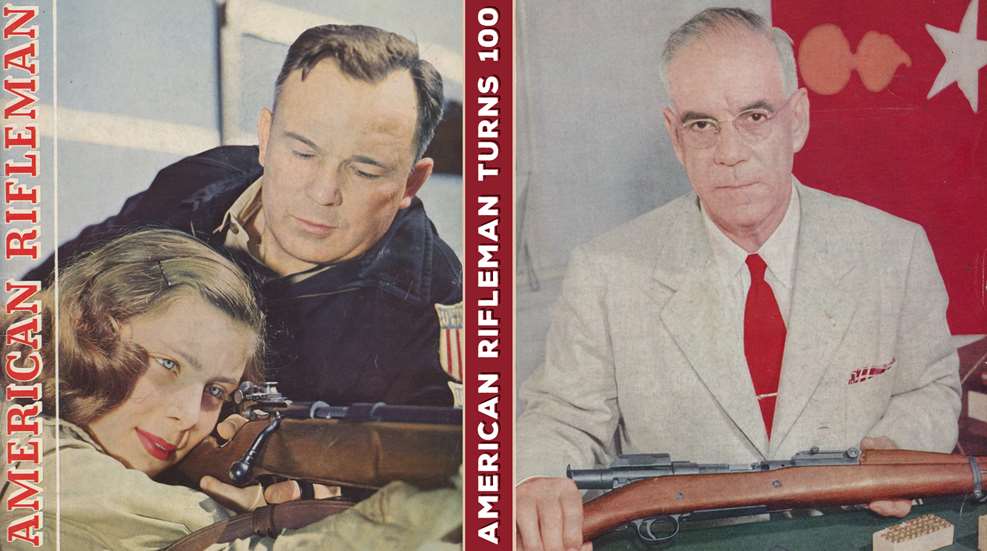
Walsh, seen above instructing his daughter, was a legendary competitive shooter, and Hatcher was a technical editor and founder of the “Dope Bag.” You can learn more about both, as well as more about our 100th anniversary, at americanrifleman.org/tar100.
"Mark, when do these magazines go out?” asked the then-new executive director of NRA Publications, Joe H. Graham, when he took over in January 2000.
“Sir, they go out on the 23rd,” I replied.
“All right, Mark. There are two things I need you to do,” Graham said. “Take Red Bell’s name out, put mine in—and I want you to take the word ‘managing’ out from in front of your title.” At that point, I had worked as the managing editor for five years and been an NRA staffer for 10.
And with that order, I became the 16th person to head American Rifleman. As this is written, I am clocking in at more than 33 years as an NRA Publications Division staffer. For 21 of those, I was grateful to be the longest-serving editor, or editor in chief, of an American institution. Even though my business card now reads “Editorial Director, NRA Publications Division”—which includes four “Official Journal” print magazines, a digital magazine, a television show and about 10 websites—I will always think of myself as a Rifleman staffer.
A New Name—And Mission
The roots of the magazine go back to 1885 and Arthur Corbin Gould’s magazine The Rifle, followed by Shooting & Fishing and then Arms & The Man—sold to NRA for the princely sum of $1 by Gen. James A. Drain in 1916. But there was a shift in 1923. From the editorials leading up to the June 23, 1923, issue, this was a magazine that was going to serve the interest of not only the members of the National Rifle Association, but also the shooting community in general. And, in no time at all, it was the biggest publication of its type. It was also the most well-edited and most diverse, covering everything from hunting jackrabbits to building your own spectrograph. It was in the pages of The American Rifleman that NRA found its voice, not only to report about the year’s winners at Camp Perry, or the newest guns, or even the oldest guns, but also to set the stage for what firearm freedom and the American experience had been and would be in the future.
“What is The American Rifleman? The American Rifleman is an association magazine whose readership is well defined and essentially has a strong common bond of interest in firearms, ammunition, their appendages, and their legitimate use on the target range, in the hunting fields, and items to be acquired, collected and enjoyed.” Those words, written in 1965, still ring true today. The next paragraph, not so much.
“The American Rifleman is the Official Journal of the NRA and is published on the first of each month. It goes to the entire membership (about 670,000), and may also be purchased at special outlets (sporting goods stores, gun shops, etc.) for 50 cents per copy. The average monthly print order is approximately 717,000 copies.”
Today, American Rifleman has a print circulation of about 1.5 million (plus an additional 100,000 who prefer to receive its digital version), but it now shares NRA’s membership with three other “Official Journals,” American Hunter (celebrating its 50th anniversary this year), America’s 1st Freedom and Shooting Illustrated. No longer is it mailed on the first of the month—these days, it’s closer to the 20th. And although we tried the newsstand (again) in the early 2000s, it is available only to NRA members through the mail or electronically.
A Tradition Of Testing
One thing that hasn’t changed in the last century is the department titled the “Dope Bag.” It was initially named after a sack or satchel used by target shooters to hold ammunition and accessories on the firing line. Ever heard of sight dope?
With the name change to The American Rifleman in 1923, the Dope Bag became a monthly column. It read, “A free service to target, big game and field shots. All questions being answered directly by mail.” Here was the initial lineup: “Rifle and Big Game Hunting, Maj. Townsend Whelen; Pistols and Revolvers, Maj. J.S. Hatcher; Shotgun and Field shooting, Capt. Charles Askins.” It was followed by the necessary disclaimer, even for then: “Every care is used in collecting data for questions submitted, but no responsibility is assumed for any accidents which may occur.” The service, now answered by staff and contributing editors, is still offered to NRA members, and you can find the instructions at the bottom of the “Questions & Answers” column. As in 1923, questions are answered directly by mail.
This area of the magazine was later handled by the Technical Dept., which was part of the NRA and Rifleman staff. It tested new guns, printed letters to our contributing editors, reviewed books and, at times, listed the latest patents. When I started out, it was its own section, but in the 1990s, those various departments were broken up in the interest of modernity. We still review books in these pages, but we do so up front now, we still print Q&As, and we, obviously, still test guns.
It was here that the first notice of a handy little pistol first appeared in November 1949 with a positive review. “We liked this little gun a lot and at the very moderate price of $37.50 it represents real value.—J.S.H.” Those are the initials of Maj. Gen. Julian S. Hatcher, who took over as technical editor in 1946 upon his retirement from the U.S. Army, and the inventor of the .22 Long Rifle pistol in question was a young William Batterman Ruger. Major General Hatcher was affiliated with The American Rifleman from the 1920s through his death in 1963.
A Change In Culture
American Rifleman has reflected the American gun culture as it has evolved. In the 1920s, most NRA members were competitive shooters, hunters, gunsmiths, collectors or all four. They wanted nothing more than to be on the line at the NRA National Matches held at Camp Perry, Ohio. But things were changing. In the 1920s, especially after World War I, there was considerable interest in smallbore rifle shooting, and more stories ran in the ’20s about the sport of pistol shooting. It was in these pages that we reported on the first police matches, the creation of a “Hogan’s Alley” tactical range at Camp Perry as part of the National Matches—whatever was evolving in terms of interest in the shooting sports.
There were times when The American Rifleman was actually leading the culture, and one of my favorite stories was titled, “This Thing of Shooting Yourself” by J.R. Mattern in the December 1932 issue. It was accompanied by a slew of don’t-try-this-at-home photos and was one of the first national efforts at publicizing hunter safety. Who knew that so many people lost their lives or digits trying to cross fences? “The lesson for the individual is simply and plainly this: familiarity breeds contempt … . Therefore, the only safe rule is never to get familiar or take liberties with any gun.” In 1948, the state of New York actually instituted the first hunter-safety program based on things that had been printed in this magazine. Who knows how many lives have been saved by the many other messages of firearm safety from NRA and its magazines?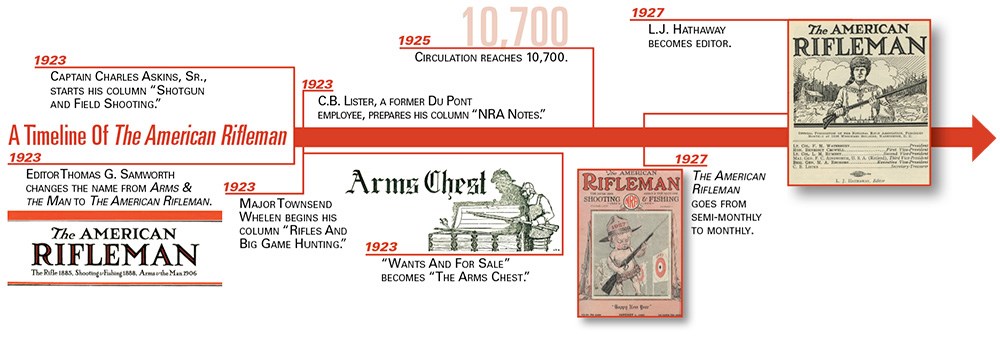
Getting Ready For War
With Hitler ascendant in Europe and Japan rising in the East, and the world about to face the greatest conflagration of our species, The American Rifleman and NRA were dedicated to national defense and preparedness. The editors had some tough questions for the U.S. Ordnance Dept. in the late 1930s. The Army was tight-lipped and said little to nothing about the new rifle designed by John C. Garand and adopted in 1936. When an article finally emerged on the “U.S. Rifle, Semiautomatic, Caliber .30, M1,” it wasn’t written by Technical Editor F.C. Ness or Editor Lawrence Hathaway, it was written by a Maj. Drewry—an Ordnance officer, not an NRA staffer. It was all the information Uncle Sam was willing to share at the time. After all, the M1 Garand before World War II was one of the biggest military secrets of the era. And the bugs of the “gas trap” Garand were not worked out until 1940. It would become the gun that freed the world in the hands of our G.I.s, but it was not quite ready; between the seventh-round stoppage and the flawed gas system, it turned out the Army really was hiding something from the editors.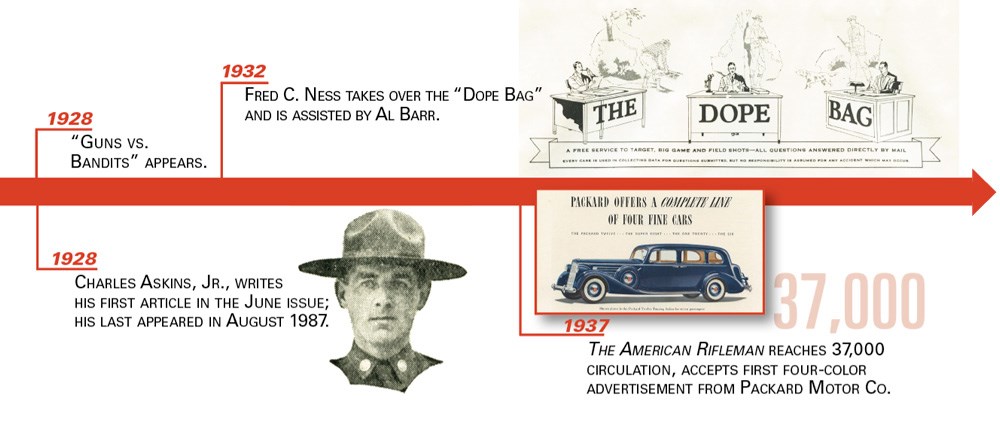
There was also lots of consternation regarding the M2 Ball .30-’06 Sprg. cartridge, because the editors regarded M1 Ball as the most superior rifle round ever developed. One of the boldest editorials ever written for this magazine was called “The Courage to be Frank,” calling out the Army for its lack of transparency. “No less than a combination of the best rifle and ammunition is good enough for the American soldier,” wrote Hathaway. “Nothing less will satisfy the NRA.”
The magazine, like the rest of our nation, went to war after Dec. 7, 1941. And NRA knew we would need to train millions of riflemen to go and preach the gospel of sight alignment, breathing and trigger control. The magazine reported on the hundreds of thousands of riflemen put through NRA’s pre-induction training program. The cover of the October 1943 issue by Pulitzer Prize-winning artist Jim Berryman said much of the NRA’s mission. “This month, by staff artist Jim Berryman, a picture of the end toward which we are all working: the end of a Nazi. There’s a sermon in this cover picture, too. Teach our fighting men to shoot, to put their slugs through the other guy’s helmet before he can put a slug through theirs—give them the guns to drive those slugs true to the mark, and armor (better than that used in the Nazi helmet pictured) to protect them while they shoot—and they’ll do the job!”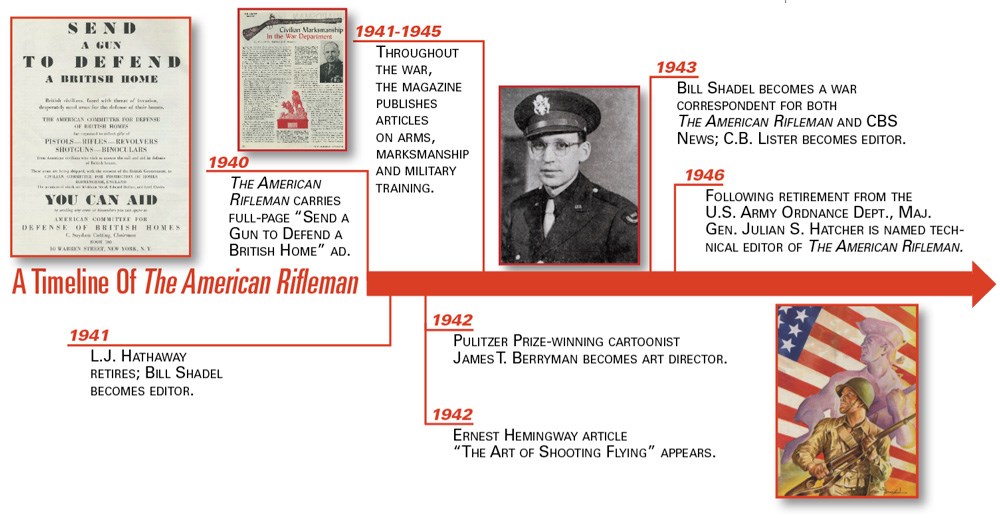
Our Man At The Front
Interestingly, in this era, Bill Shadel, once a circus roustabout but also a very talented writer and editor, became a staffer and, eventually, the editor. But Shadel decided to ship out in 1943; every able-bodied NRA staffer served in uniform during the war. With credentials from both The American Rifleman and the Infantry Journal, Shadel set out for North Africa, then Sicily, Italy and France. Shadel was a serious newsman, and his stories reporting from the Mediterranean theater, and even on D-Day, kept the rifleman at home in the know. Shadel fell in with the wrong crowd, meaning Edward R. Murrow, and you can actually hear him broadcast from the D-Day landing on June 6, 1944. Shadel eventually became a radio newsman, then was in on the infancy of television. Just in case you were wondering who hosted that Nixon-Kennedy debate, yeah, that was a former editor of American Rifleman.
While this magazine has reported on military arms since its beginnings, the only war correspondent to head for a battle zone since Bill Shadel came home in 1945 was NRA’s Phil Schreier. As things were heating up in the Persian Gulf in 2003, Phil came to me and asked to be a correspondent. The TV show was going by then, so we sent a cameraman with him. My last words to him before departure were, “For Pete’s sake, Phil, don’t die over there!” Phil did a few TV shows and a magazine article on his experiences, and there is even a book in the works.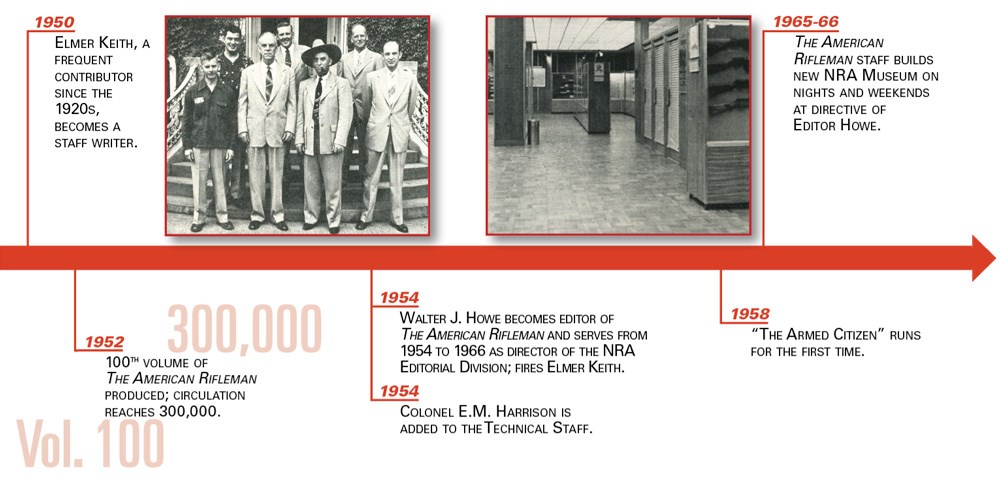
The Roaring ’50s
In 1954, Walter J. Howe, the author of Professional Gunsmithing: A Textbook on The Repair and Alteration of Firearms, was appointed editor of the magazine and head of the NRA Editorial Division. He would serve until 1966. Howe wrote, “Editors and writers are, as a rule, called by different names because they perform different functions. An analogy can be drawn by comparing a farmer to a cook. The farmer has certain knowledge that he applies and as a result grows grains, vegetables, and fruits. The cook, on the other hand, takes these ingredients and serves them up so that they appeal to a great number of people.” That may be true, but not when it has come to Rifleman staffers. Here, you have to be both an editor and a writer, and that is a tradition that goes back decades.
But it has been the editors, working with great writers, who have “served up” this magazine. There were great names when it comes to the writers of yesteryear, men like Julian S. Hatcher, Townsend Whelen, Elmer Keith, Rex Applegate, Charles Askins, Sr., and Charles Askins, Jr., Wiley Clapp, Pete Dickey and Finn Aagaard. Ed McGivern offered up an article on speed shooting, and W.M.D. Bell wrote about African cartridges. There was even an article by Ernest Hemingway. More recently, Field Editor Bruce N. Canfield has been contributing for more than a quarter century, and there also have been appearances from New York Times best-selling author Stephen Hunter, who remains my only Pulitzer Prize-winning friend. There are some great new writers, too—read anything you can by Field Editors Justin Dyal and Jeremiah Knupp.
Howe set the tone for the magazine under the direction of Marine Gen. Merritt “Red Mike” Edson, who was awarded the Medal of Honor after Guadalcanal and ran NRA as its executive director in the early 1950s. What a dream team that must have been. Howe once told me he was on a first-name basis with Julian S. Hatcher. “He called me Walter, and I called him General.”
In September 1958, Howe started a column that has run monthly ever since. You can find it on p. 10 of this magazine, and it is called “The Armed Citizen.” Here is how he put things in motion. “Law enforcement officers cannot at all times be where they are needed to protect life or property in danger of serious violation. In many such instances, the citizen has no choice but to defend himself with a gun. Below are accounts of recent instances digested from newspaper clippings sent in by NRA members.” In one early instance, “Dr. P.W. Bowman of Washington, D.C., was awakened at 5 a.m. by cries for help from the home of a 91-year-old neighbor. The 69-year-old doctor leaped from his bed, grabbed his pistol, and reached the street just as an armed man was coming from the neighbor’s house. He ordered the robber to drop his gun and held them at bay while his wife called police. The police found the aged victim had been beaten and robbed.” Such stories had appeared in the magazine certainly since 1928 under the name “Guns vs. Bandits.”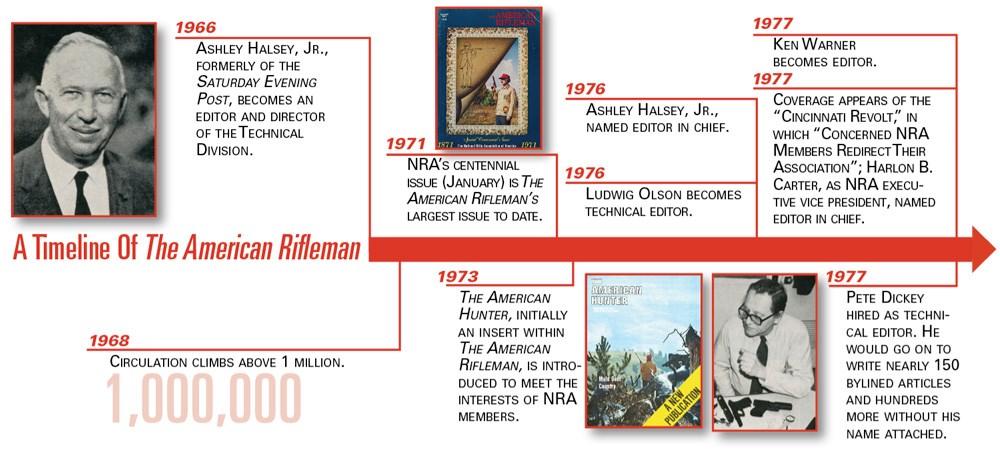
Building A Museum on The Side
Rifleman is looked upon as just a magazine, well, and a website and a television show now, but there was a time that The American Rifleman and the Technical Division had a much broader scope within the NRA. Under Editor Walter J. Howe, the National Firearms Museum fell under the Technical Division and the magazine. So, in 1965, the magazine and technical staffers were tasked with developing a new museum at the NRA’s then-new headquarters at 1600 Rhode Island Ave. in Washington, D.C. That museum was where I started as curatorial assistant.
I got to know Walter J. Howe, and I found him to be one of the most brilliant and profane men I have ever encountered, even into his 90s. He talked about making his staff build what was, for decades, the NRA National Firearms Museum on nights and weekends as a condition of their employment. He made them create exhibit cases, identify guns and write text. As he told me over the phone once, “I guess you can’t [expletive] do that anymore?” To which I replied, “No, Walter, I’m pretty sure I can’t.” He sighed and wondered what happened to this world. That said, the legacy of those efforts—with better lighting and context—can be seen today at the NRA National Firearms Museum in Fairfax, Va.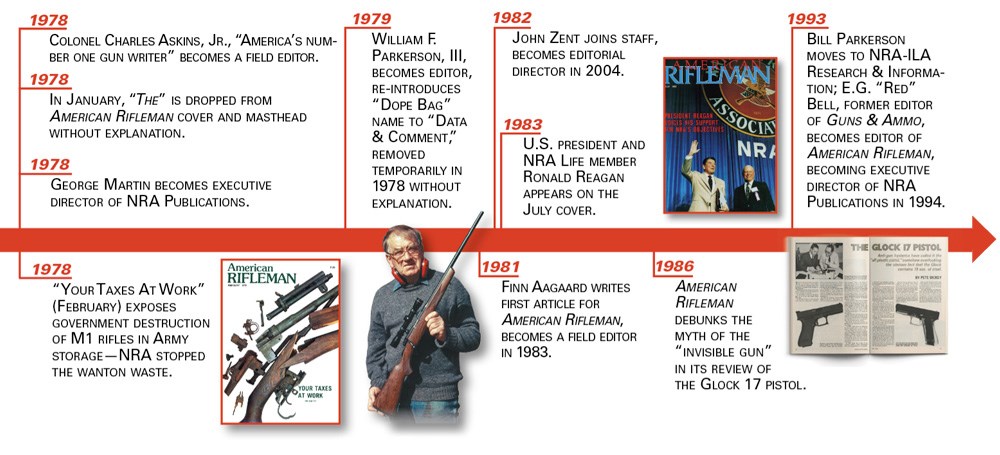
A veteran Editor Defends NRA
Ashley Halsey, Jr., who came here from the Saturday Evening Post, took over as editor in 1966, and through hard-hitting editorials, set the tone for the debates that surrounded the 1968 Gun Control Act and its aftermath. But Halsey did far more than that. He was a gun collector through and through, passing on his love of guns and history. Through articles on historical arms, owned by the like of Presidents Washington, Jefferson and Lincoln—plus articles by George C. Neumann on Revolutionary War arms—he set the tone and the record straight on the guns of our nation’s founders.
Defending the Second Amendment occurred monthly in the magazine’s pages. The formula was simply well-written and -reasoned editorials in the pages of Rifleman, giving NRA members all they needed to know to oppose repressive gun laws for generations. And those words were written by Ash Halsey, who like William F. Parkerson, III, the editor in chief in my era, could write about guns or politics equally as deftly and succinctly.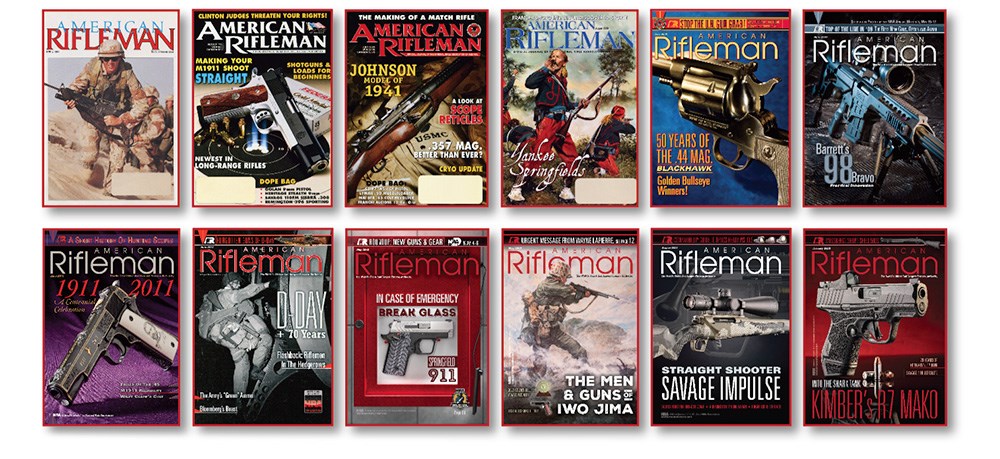
Halsey wrote the following in June 1977, and it rings true and timeless. “For decades, U.S. gun owners have been politely saying that gun registration leads to firearms confiscation. Yet the anti-gun element has remained strangely unimpressed, although booted troopers seized private firearms as one of the first moves in Mussolini’s Italy, Hitler’s Germany, the Nazi occupation of Europe, and Communist take-overs after World War II. Intense animosity toward guns has even blinded some sincere supporters of constitutional rights to the fact that law-abiding Americans have a right to own and use guns. Anti-gun spokesmen assert that registration of guns is just like registration of cars, so why should anyone object? As events prove, the two are far different. One big difference is that gun registration can lead to confiscation.”
As you can see in these pages every month, American Rifleman still gives our members the tools and information needed, and each issue has about eight pages of political information to help NRA members stay informed.
A Legacy For Members
There’s a legacy here. And it’s not only passed down through the pages that one can access in the archives—no, it’s cultural. I’ve been in this for most of my adult life, and I’ve been mentored by some of the most impressive people to ever have an NRA business card, including Editor Bill Parkerson, and the best managing editor the magazine has likely ever had, Ron Keysor. When I started, after a year in the museum, I was hired onto the Technical Staff. And while it no longer exists, that culture remains. It started with F.C. Ness, then Maj. Gen. Julian S. Hatcher, was passed down to Bud Waite, then through Ludwig Olson, whose company I enjoyed immensely. Then there was the formidable, but mirthful and brilliant, Pete Dickey, who plucked me out of obscurity to make me a real Rifleman staffer. Robert W. Hunnicutt took over for Pete, taught me, mentored me and remains one of the finest gunwriters of all time. Lastly, there was Mike Bussard, the last of our technical editors, and one of the nicest men I’ve ever met. Although he worked mostly on Hunter then, my predecessor as editorial director, John R. Zent, deserves special mention for maintaining and leading the culture.
Thanks to those men, we do not compromise on how we test guns. “The American Rifleman magazine has few taboos,” wrote Walter Howe in 1965. “However, we will not consider for publication anything that ‘winks’ at law breaking or delineates practices that are inimical to the best interests of gun ownership, shooting or good citizenship.”
Hatcher set up most of it, and Dickey codified it for generations. We have set protocols that we continue to use when testing guns: a certain number of rounds—usually five consecutive, five-shot groups—fired at a certain distance when testing guns; always chronographing and looking for signs of pressure or malfunction; and many more. When you see an accuracy table in this magazine, one of us or a trusted contributor shot the gun—and suppressors now—using these time-tested criteria. You can see the “Data & Comment” for yourself on every gun reviewed in the magazine.
Our editors do have a reporting system that leads to NRA Publications Executive Director Doug Hamlin (a good boss, by the way), but they work day-in and day-out for NRA’s members. We have a culture of honesty and discretion. We have a system—and it works. For shooters, competitive or recreational, hunters whether they be after dangerous game or small, or those who are concerned about their personal safety or liberty, it has become the publication of record for all things to do with the shooting sports and the Creator-endowed right to pursue one of the most fundamental aspects of human freedom.
The editors of this magazine today—Brian C. Sheetz (the 17th editor in chief), Kelly Young, Evan Brune and Christopher Olsen—are upholding the traditions of Hathaway, Howe, Halsey, Dickey, Parkerson and all the other editors that came before them. It is a legacy of service to NRA members and the freedom we all hold precious. I wish American Rifleman as much success in its next century as it has had in the past one, because that is what the members of the National Rifle Association deserve.
Even though I’m not on Rifleman day-to-day anymore (the Publications Division has to have an editorial director, after all), my heart still remains with the magazine that I have cherished since I was a middle schooler running home to get it out of the mailbox about the first of the month, read it and then smooth the pages over, so it didn’t look like it had been read. When my Uncle Mark came home, he looked forward to his time in our family room, where he would open the magazine and start reading. I do that still when my personal copy comes, even in the years that I had to read every page five times before it made it to your mailbox. I open mine, sit in my chair, and for those moments am just a Rifleman reader. It is my hope that, somewhere, there is a future editor of American Rifleman doing the exact same thing.





































